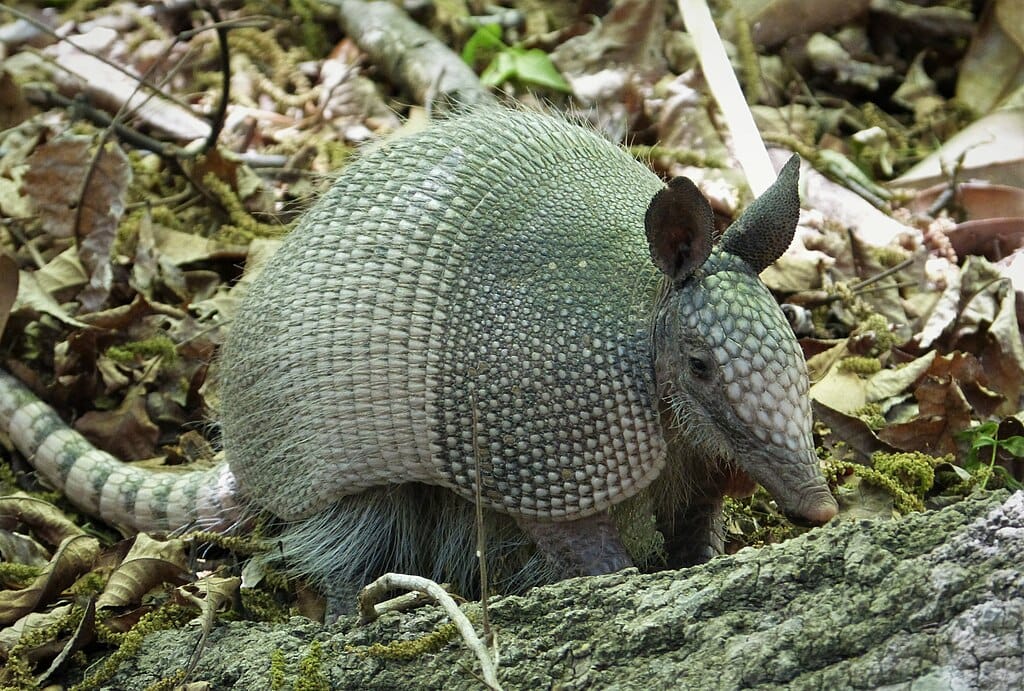armadillo

The armadillo is a largely nocturnal American mammal of the order Cingulata. There are a number of species of armadillo, of which the nine-banded armadillo (Dasypus novemcinctus) is perhaps the most familiar to English speakers. That species is found in South and Central America and in the southeastern United States, as far west as Texas and as far north as Nebraska and is the only species of armadillo common to the United States.
Armadillo has a straightforward etymology. Its name comes from its keratinous skin that forms a leathery, armored carapace about its head, upper body, and tail. The word is a borrowing from Spanish, armado (“armored,” past participle of armar) + -illo (diminutive suffix). So an armadillo is literally a “little armored one.”
The word appears in Spanish in Nicolas Monardes 1571 De las cosas que se traen de nuestras Indias Occidentales, que siruen al vso de medicina (Of the Things that Are Brought from Our West Indies, which Serve as Medicine). That work was translated into English in 1577 later by John Frampton, which is the first known use of the word in English:
Thei dooe bryng also from the firme lande a bone, the whiche is of the taile of a straunge beaste, whiche is all couered ouer with small shelles, euen unto the feete, like as Horse is couered with armour: where by he is called the Armadillo, that is to saie a beaste armed. He is of the greatnesse of a yonge Pigge, and in the snoute he is like unto hym, he hath a greate and long taile like to a Lizarde. He abideth or dwelleth in the yearth, as a Mole doeth, and thei saie that he is maintained thereof, for abroade out of the yearth, thei see hym not eate any thyng.
Another early English use, with a slightly different spelling and clearly cribbed from Frampton’s translation, can be found in Thomas Blundeville’s 1594 His Exercises Containing Sixe Treatises:
The beast Armadillio is found in the Realme of Mexico, and he is no bigger than a cat, hee is headed like a Swine, and hath the féet of a Herison, and a long tayle, he is armed with scales, whereof he taketh his name, he keepeth for the most part within the ground, and as some suppose, doth liue by the earth, by reason that he is neuer seene to eat abroad out of his den, the bones of his tayle are medicinable, and do remedie the paine and deaffnes of the eares.
When I lived in Texas, I would occasionally encounter armadillos in the summer when walking my dog in the pre-dawn hours (to avoid the heat). It is indeed an odd-looking creature, stranger in real life than it appears in photos.
Sources:
Blundeville, Thomas. His Exercises Containing Sixe Treatises. London: John Windet, 1594, 261v. ProQuest Early English Books Online (EEBO).
Monardes, Nicolás. Segunda parte del libro de las cosas que se traen de nuestras Indias Occidentales, que siruen al vso de medicina. Seville: Alonso Escribano, 1571, 96. HathiTrust Digital Library.
———. The Three Bookes Written in the Spanish Tonge by the Famous Phisition D. Monardes. John Frampton, trans. London: William Norton, 1577, sig. fol. 73v. ProQuest Early English Books Online (EEBO).
Oxford English Dictionary Online, March 2016, s. v. armadillo, n.
Photo Credit: Gail Hampshire, 2017. Wikimedia Commons. Licensed under a Creative Commons Attribution 2.0 Generic license.